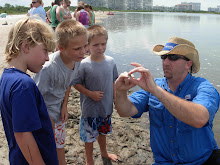On Saturday I had the privledge of participating in the first annual Pine Island Scallop Search put on my colleague Joy Hazell, the Lee County Sea Grant Extension Agent and the Sannibel Captiva Conservation Foundation. The event is a resource‐monitoring program where volunteers snorkel, looking for scallops in select areas within Pine Island Sound. The purpose of this program is to monitor and document the health and status of the bay scallop population, and is modeled off of the successful Great Bay Scallop Search conducted in Tampa Bay since 1993. One hundred and twenty volunteers participated in the event and 335 scallops were counted!!!
Unfortunately, we don't have many bay scallops in Collier County, but they are fascinating animals, and I must say absolutely delicious! I thought you'd enjoy some more information about them.
(Content take from Betty Staugler, Charlotte County Sea Grant Extension Agent) The Florida bay scallop is a bivalve mollusk that grows and lives in seagrass beds in relatively shallow water, 4 to 10 feet deep. At one time scallops could be found from Palm Beach to Pensacola. Today, consistently healthy populations can only be found in selected locations along Florida's West Coast - principally St. Joseph Bay, and the area between the Econfina and Weeki Wachee rivers.
In recent years, bays scallops have been seen in greater numbers in southwest Florida waters, in part due to restoration efforts in the area. With greater awareness of their recovery, unfortunately come many reports of illegal harvesting. Readers should be aware that recreational harvest of bay scallops is prohibited in all southwest Florida waters.
Legal Requirements
In Florida, commercial harvest of bay scallops is prohibited. Recreational harvest is allowed only in state waters from north of the Pasco-Hernando county line to the west bank of Mexico Beach Canal and only during a limited season, typically July 1 through September 10. For 2010, FWC allowed an early opening date, June 19, to provide economic relief to those counties which rely heavily on the tourism industry associated with scalloping and might be impacted by loss of revenue from perceived impacts of the oil spill. All other rules remained in place, including the boundaries of the approved harvest areas and the harvest limits.
For readers interested in traveling to the Big Bend during the recreational harvest season a few rules apply. In general, recreational scallopers between the ages of 16 and 65 must have a current Florida saltwater fishing license to collect scallops. There are some exceptions; these are listed in the FWC "Florida Recreational Saltwater Fishing Regulations," which is available in bait shops, FWC offices, or at the FWC web site. All non-residents over the age of 16 are required to buy a license unless they are fishing (scalloping) from a for-hire vessel (guide, charter, party boat) that has a valid vessel license
To learn more about the life history and ecology of bay scallops click here.
To participate in future bay scallop search events in Southwest Florida you can contact:
Betty Staugler: Charlotte County Sea Grant Extension Agent: 941-764-4340
Joy Hazell: Lee County Sea Grant Extension Agent: 239-533-7518
Unfortunately, we don't have many bay scallops in Collier County, but they are fascinating animals, and I must say absolutely delicious! I thought you'd enjoy some more information about them.
(Content take from Betty Staugler, Charlotte County Sea Grant Extension Agent) The Florida bay scallop is a bivalve mollusk that grows and lives in seagrass beds in relatively shallow water, 4 to 10 feet deep. At one time scallops could be found from Palm Beach to Pensacola. Today, consistently healthy populations can only be found in selected locations along Florida's West Coast - principally St. Joseph Bay, and the area between the Econfina and Weeki Wachee rivers.
In recent years, bays scallops have been seen in greater numbers in southwest Florida waters, in part due to restoration efforts in the area. With greater awareness of their recovery, unfortunately come many reports of illegal harvesting. Readers should be aware that recreational harvest of bay scallops is prohibited in all southwest Florida waters.
Legal Requirements
In Florida, commercial harvest of bay scallops is prohibited. Recreational harvest is allowed only in state waters from north of the Pasco-Hernando county line to the west bank of Mexico Beach Canal and only during a limited season, typically July 1 through September 10. For 2010, FWC allowed an early opening date, June 19, to provide economic relief to those counties which rely heavily on the tourism industry associated with scalloping and might be impacted by loss of revenue from perceived impacts of the oil spill. All other rules remained in place, including the boundaries of the approved harvest areas and the harvest limits.
For readers interested in traveling to the Big Bend during the recreational harvest season a few rules apply. In general, recreational scallopers between the ages of 16 and 65 must have a current Florida saltwater fishing license to collect scallops. There are some exceptions; these are listed in the FWC "Florida Recreational Saltwater Fishing Regulations," which is available in bait shops, FWC offices, or at the FWC web site. All non-residents over the age of 16 are required to buy a license unless they are fishing (scalloping) from a for-hire vessel (guide, charter, party boat) that has a valid vessel license
To learn more about the life history and ecology of bay scallops click here.
To participate in future bay scallop search events in Southwest Florida you can contact:
Betty Staugler: Charlotte County Sea Grant Extension Agent: 941-764-4340
Joy Hazell: Lee County Sea Grant Extension Agent: 239-533-7518
 |
| A bay scallop sits on the bottom of a sea grass bed |
 |
| Healthy seagrass communities and good water quality are crucial to having viable bay scallop populations |
 |
| Add caption |
 |
| The "eyes" of a scallop are a defining characteristic of the bivalve mollusk |
























